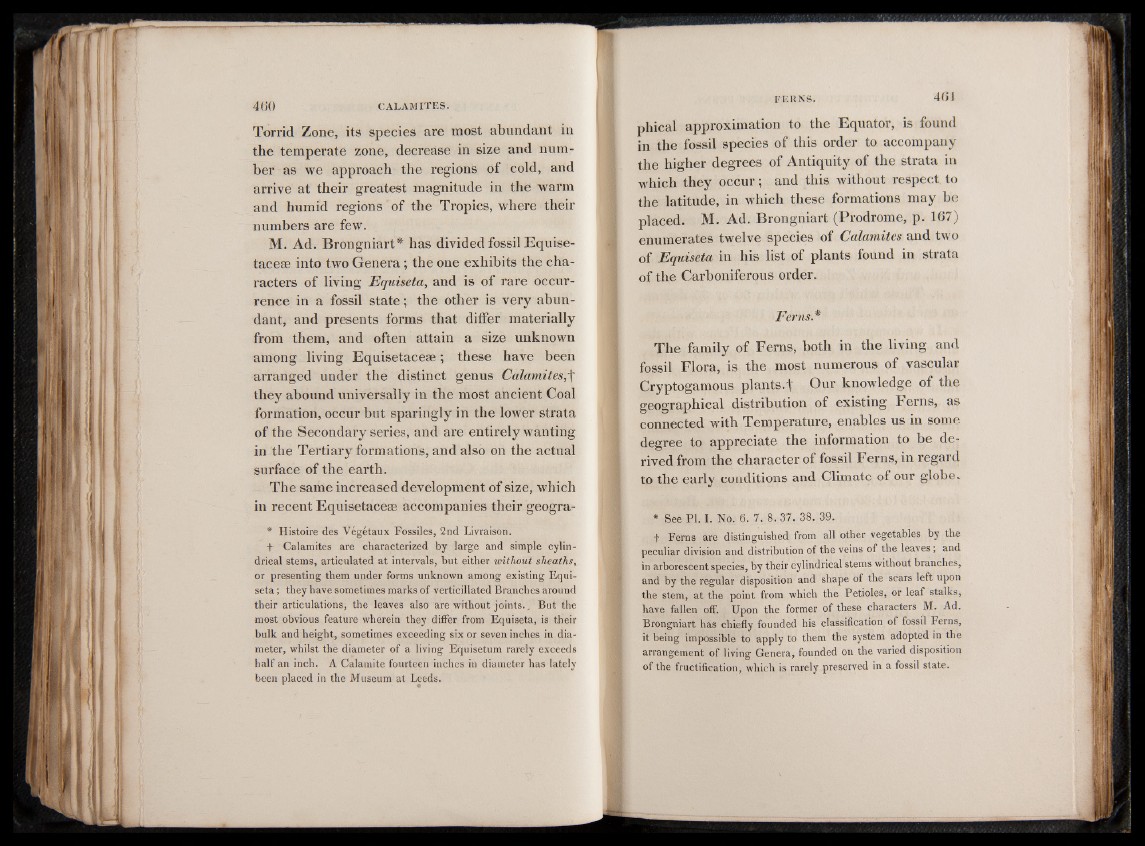
Torrid Zone, its species are most abundant in
the temperate zone, decrease in size and number
as we approach the regions of cold, and
arrive at their greatest magnitude in the warm
and humid regions of the Tropics, where their
numbers are few.
M. Ad. Brongniart* has divided fossil Equise-
taceæ into two Genera ; the one exhibits the characters
of living Equiseta, and is of rare occurrence
in a fossil state ; the other is very abundant,
and presents forms that differ materially
from them, and often attain a size unknown
among living Equisetaceae ; these have been
arranged under the distinct genus Calamites,f
they abound universally in the most ancient Coal
formation, occur but sparingly in the lower strata
of the Secondary series, and are entirely wanting
in the Tertiary formations, and also on the actual
surface of the earth.
The same increased development of size, which
in recent Equisetaceae accompanies their geogra-
* Histoire des Végétaux Fossiles, 2nd Livraison.
f Calamites are characterized by large and simple cylindrical
stems, articulated at intervals, but either without sheaths,
or presenting them under forms unknown among existing Equiseta
; they have sometimes marks of verticillated Branches around
their articulations, the leaves also are without joints.. But the
most obvious feature wherein they differ from Equiseta, is their
bulk and height, sometimes exceeding six or seven inches in diameter,
whilst the diameter of a living Equisetum rarely exceeds
half an inch. A Calamite fourteen inches in diameter has lately
been placed in the Museum at Leeds.
FERNS. 401
phical approximation to the Equator, is found
in the fossil species of this order to accompany
the higher degrees of Antiquity of the strata in
which they occur ; and this without respect to
the latitude, in which these formations may be
placed. M. Ad. Brongniart (Prodrome, p. 167)
enumerates twelve species of Calamites and two
of Equiseta in his list of plants found in strata
of the Carboniferous order.
Ferns*
The family of Ferns, both in the living and
fossil Flora, is the most numerous of vascular
Cryptogamous pi ants, t Our knowledge of the
geographical distribution of existing Ferns, as
connected with Temperature, enables us in some
degree to appreciate the information to be derived
from the character of fossil Ferns, in regard
to the early conditions and Climate of our globe.
* See PI. I. No. 6. 7. 8. 37. 38. 39.
t Ferns are distinguished from all other vegetables by the
peculiar division and distribution of the veins of the leaves ; and
in arborescent species, by their cylindrical stems without branches,
and by the regular disposition and shape of the scars left upon
the stem, at the point from which the Petioles, or leaf stalks,
have fallen off. Upon the former of these characters M. Ad.
Brongniart has chiefly founded his classification of fossil Ferns,
it being impossible to apply to them the system adopted in the
arrangement of living Genera, founded on the varied disposition
of the fructification, which is rarely preserved in a fossil state.